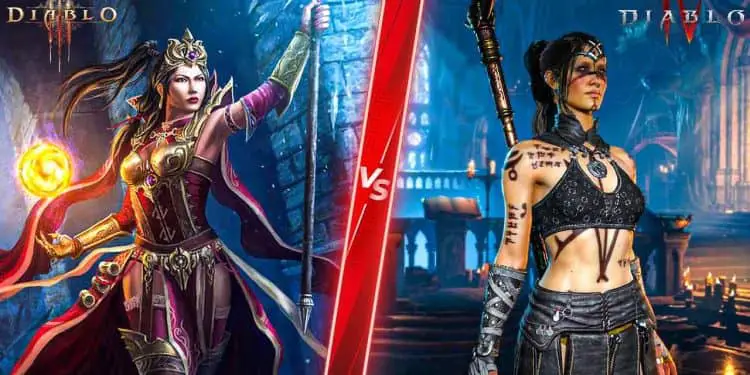Caught in a dilemma between the captivating appeal of Diablo 3 and the menacing charm of Diablo 4? Jump right into this detailed comparison, evaluating the unique features, narratives, and visuals of each game.
Our aim is to assist you in choosing between the rapid-fire action of Diablo 3 and the tactical gameplay of Diablo 4. So, strap in as we journey through the blazing depths of these legendary games to determine the ultimate champion of the Diablo series.
Key Takeaways
Diablo 3 and Diablo 4 both offer engaging gameplay, but they differ in pacing and style. Diablo 3 is faster-paced with a lighter tone, while Diablo 4 returns to a darker atmosphere and features more methodical combat. Players’ preferences will determine which game is better, as both have their unique strengths and weaknesses
The Evolution of the Diablo Series

The Diablo series has seen a fascinating journey since its inception, with each iteration bringing forth significant changes in storytelling, combat mechanics, visual design, and other elements.
Diablo 3, for instance, offered an extensive narrative but fell short of capturing the series’ distinctively dark tone. Diablo 4, the upcoming release, promises to reestablish this ominous atmosphere by focusing on the demon Lillith and her enigmatic motives.
Combat mechanisms have also seen a shift. Diablo 3’s combat was predominantly hack-and-slash, while Diablo 4 is set to employ a slower, more strategic approach.
From a visual standpoint, Diablo 4 surpasses its predecessor with a chilling aesthetic that aligns perfectly with its storyline. The soundtrack contributes to the immersive experience, enhancing the overall gameplay.
Each iteration has its unique strengths, but it seems Diablo 4 has learned valuable lessons from Diablo 3. It aims to offer a more polished gaming experience, demonstrating the series’ continual evolution.
Story Arcs: Diablo 3 vs Diablo 4
Looking at the narrative shifts between Diablo 3 and Diablo 4, there’s a clear change in atmosphere.
Diablo 3, though complex, seems to miss the mark on the series’s trademark dark vibes. Its plot, shining with a hopeful tone and an array of villains, strays from the somber stories of previous games.
On the flip side, Diablo 4 takes a step back to the series’s roots. Its story, revolving around the demon Lilith, is ominous and chilling, reflecting the dark aesthetic that fans have grown to appreciate. The interactions between humans and Lilith’s objectives are thoroughly examined, lending more depth to the narrative.
This change in tone reveals Blizzard’s intent to align the game’s story with its brooding, gothic atmosphere, which enriches your immersion into the Diablo universe.
Gameplay Mechanics: What Sets Them Apart?

Between Diablo 3 and Diablo 4, the changes in gameplay mechanics, from the rhythm of battles to the handling of treasures, distinguish these two games in the Action Role-Playing Game (ARPG) genre.
Diablo 3 offers quick, action-packed combat, emphasizing flamboyant abilities and swift treasure collection.
In contrast, Diablo 4 leans towards a more measured, strategy-focused style of play. This game encourages you to carefully harmonize your character’s abilities and equipment for successful battles.
Handling treasures in Diablo 4 also calls for a sharp focus on statistics, rarity, and how they align with your chosen character build. It’s not just about strength; it’s about strategic planning and optimization.
These differences between Diablo 3 and Diablo 4 showcase the progression of the Diablo series, highlighting Blizzard’s commitment to depth, intricacy, and player autonomy in their ARPGs.
Visual Aesthetics: A Generational Leap
There’s no doubt that Diablo 4 demonstrates a substantial advancement in visual aesthetics. The graphics, avatar models, and environmental design embody this tonal shift. The intricacy of the detail is awe-inspiring, conjuring up an absorbing, visually lavish gaming experience.
However, Diablo 3 emanates its own enchanting charm. The artistic direction of Diablo 3, characterized by vibrant hues and animation-inspired design, may seem somewhat disconnected from the series’ somber origins. Yet, it provides an exclusive visual panache that distinguishes it from the rest.
Conversely, Diablo 4 reverently acknowledges the bleak, gothic atmosphere of the preceding games, illustrating a universe teetering on the edge of annihilation. Though contrasting in their essence, both games manifest an impressive degree of visual finesse, each exuding its own unique aesthetic charm.
Soundtracks: Setting the Mood

While engaging in fierce battles in both games, it’s Diablo 4’s soundtrack that underscores the spine-chilling ambiance, outperforming Diablo 3’s symphonic score with its eerie harmonies.
The acoustic design of Diablo 4 is more engrossing, reverberating the terror and hopelessness of Sanctuary’s grim reality. Diablo 3’s music, despite being exquisitely arranged, fails to fully encapsulate the essence of a universe teetering on the edge of destruction.
In contrast, Diablo 4’s soundtrack is as expressive as possible. The creepy melodies and foreboding undertones blend flawlessly with the dark visuals, crafting an ambiance that’s unmistakably Diablo. Each pluck, rhythm, and chorus is custom-made to elevate your gaming experience, whether you’re investigating cursed ruins or going head-to-head with Hell’s armies.
When it comes to the music, Diablo 4 decidedly tops its precursor.
Online Features: Blessing or Curse?
In Diablo 4, the online features heavily influence your gaming adventure, which could be perceived as either a boon or a bane. The internet-based universe engenders a sense of collective peril and unity, with unexpected interactions with other gamers enhancing your expedition through Sanctuary.
However, persistent online connectivity might raise worries about server reliability, lag, and possible interruptions in gameplay – challenges not encountered in a strictly solo gameplay.
Recall the contentious auction house in Diablo 3? It’s no longer present in Diablo 4, supplanted by player-to-player trading, a beloved aspect of Diablo 2. This modification improves your gear seeking adventure.
However, be cautious of the possibility of upcoming microtransactions – a pattern increasingly seen in numerous online games recently.
Microtransactions: A Necessary Evil?

The concept of microtransactions in Diablo 4 is something you’re wrestling with. They’ve become a staple in the gaming industry, yet you’re aware of the potential effects they could have on your gaming journey. You know they can introduce additional content, but at the cost of player’s finances and this leaves you uncertain about their influence on your adventures in Sanctuary.
The real-money auction house in Diablo 3 had a negative impact on the game’s image. It upset the balance, rendering the hunt for powerful loot less satisfying.
Blizzard has confirmed that Diablo 4 will only include microtransactions for cosmetic items. However, it’s smart to remain skeptical. Cosmetic items contribute to player individuality and self-expression, and putting them behind a paywall might lessen your enjoyment of the game. You’re staying vigilant, eager to see how Blizzard handles this tricky situation.



